4 Common Instructional Designer Archetypes

Navigating the ID Landscape
Instructional Design, as a discipline, is a mosaic of expertise, methodologies, and skill sets. It’s not just about designing a curriculum; it’s about understanding the learner’s journey, leveraging technology, mastering pedagogical theories, and so much more.
Within this vast expanse, we can discern at least four primary archetypes – overarching categories that define the core essence of certain roles and individual expertise in the ID realm.
But it’s essential to note that these archetypes are not rigid silos. In the dynamic world of Instructional Design, professionals might find themselves resonating with multiple archetypes. Those who do are not just jacks-of-all-trades; they’re masters of many, holding immense value in the fluid, ever-evolving landscape of education and training.
This exploration aims to map out the ID landscape, providing clarity to the roles and celebrating the multifaceted expertise of every Instructional Designer.
Educational Technologist
Instructional Designer
About this Archetype
The Educational Technologist Archetype in Instructional Design emphasizes a deep understanding of, well, educational technology. These Instructional Designers are adept at both software and hardware, understanding the nuances of each tool and how they can be best leveraged for optimal learning experiences. They’re the ones you turn to when you need a high-tech solution, whether it’s integrating the latest eLearning authoring tools or setting up a virtual reality learning environment.
- Strengths
-
Technological Proficiency:
Has an in-depth understanding of modern authoring tools, platforms, and hardware.
-
Solution-Oriented:
Quickly identifies the best ed tech for specific educational challenges.
-
Continuous Learner:
Keeps up-to-date on the latest ed tech trends and advancements.
-
Efficiency in Execution:
Can quickly create prototypes and identify methods for integrating new ed tech.
-
Technical Troubleshooting:
Has the expertise to diagnose and resolve ed tech-related issues.
- Struggles
-
Over-reliance on Technology:
Might lean too heavily on tech solutions, even when simpler methods might suffice. -
Potential Overwhelm:
The rapid evolution of technology means there’s always something new to learn, leading to potential feelings of being overwhelmed. -
Balancing Tech with Pedagogy:
While excelling in tech, there’s a risk of sidelining pedagogical principles in favor of flashy tech solutions. -
Hardware Limitations:
Designs may be for the latest tech, but not all learners might have access and the proclivity to such advanced resources. -
Visual Design for Learning:
Their focus on technical aspects might mean they’re not as skilled or experienced in the nuances of visual design specifically tailored for educational content.
In a nutshell…
This archetype remains a vital asset for teams eager to utilize the latest in technology for educational endeavors. Their profound technical expertise ensures that the learning experiences are not only impactful but also dynamic and state-of-the-art.
Design Expertise
Instructional Designer
About this Archetype
The Design Expertise Archetype in Instructional Design focuses primarily on the design aesthetics, usability, and learner experience of educational materials. These Instructional Designers have an innate sense of what looks and feels right, ensuring that content is not only informative but also engaging and visually appealing. They bridge the gap between content and the learner, ensuring that materials are accessible, intuitive, and memorable.
- Strengths
-
Visual Design:
Has a good sense of design aesthetics and understands how to use visuals to enhance learning.
-
User-Centered Design:
Prioritizes the learner’s experience, ensuring content is accessible and resonates with the intended audience.
-
Multimedia Integration:
Skilled at integrating graphics, videos, animations, and other multimedia elements to enhance and enrich the learning experience.
-
Cohesive Branding:
Ensures that all learning materials maintain a consistent look and feel.
-
Iterative Process:
Embraces feedback and continually refines designs to optimize learner engagement and understanding.
- Struggles
-
Balancing Form and Function:
May risk overemphasizing aesthetics over content quality or depth.
-
Technology Limitations:
Their designs may be hindered by platform or tech limitations.
-
Keeping Up with Design Trends:
The world of design is constantly evolving, and staying current on relevant modern design trends may be time-consuming and difficult.
-
Subjectivity:
Design can be subjective, leading to potential disagreements or revisions based on differing tastes.
In a nutshell…
The Design Expertise Archetype brings beauty and life to instructional materials. These IDs can help transform potentially boring content into captivating and visually appealing experiences. They play an essential role in sustaining learner interest and knowledge retention.
Learning Theorist
Instructional Designer
About this Archetype
Instructional Designers who align with the Learning Theorist Archetype are the educational theorists of the ID world. They have a deep understanding of how people learn, whether it’s children (pedagogy) or adults (andragogy). With their grounding in educational theory, these IDs ensure that learning experiences are not only effective but also tailored to the cognitive and motivational needs of the target audience.
- Strengths
-
Educational Theorist:
Profound understanding of various learning theories and their application to diverse learning scenarios. -
Learner-Centered Approach:
Focuses on the unique needs, motivations, and challenges of learners, ensuring tailored experiences. -
Instructional Strategies:
Utilizes a wide array of teaching methods and strategies, matching them to specific learning outcomes and learner profiles. -
Assessment Mastery:
Designs robust evaluation methods to gauge learning effectiveness and learner comprehension. -
Continuous Improvement:
Regularly revisits and refines learning strategies based on feedback and evolving educational research.
- Struggles
-
Over-Complexity:
May sometimes design overly complex learning experiences, grounded in theory but challenging for some learners to grasp. -
Balancing Theory with Practicality:
Theoretical foundations are crucial, but there’s a need to ensure they align with real-world contexts and resources. -
Adapting to Rapid Change:
The educational world evolves, and staying current with both theory and practice can be demanding. -
Tech Limitations:
Some advanced pedagogical strategies might be challenging to implement with available technology. -
Broad Scope:
The wide range of theories and methods can sometimes lead to analysis paralysis or a lack of focus in design.
In a nutshell…
The Learning Theorist Archetype plays a pivotal role in ensuring that instructional materials are not only informative but also instructionally sound. Their emphasis on the science of learning ensures that content is both engaging and deeply effective, helping learners to truly internalize and apply their new knowledge.
Subject Matter Expert
Instructional Designer
About this Archetype
The Subject Matter Expert (SME) ID possess deep domain knowledge while also possess the ability to apply sound instructional design practices. These IDs may come from a background where they’ve acquired specialized knowledge, and then transition into the role of designing training for that subject. Overall, their in-depth understanding of the subject matter ensures accuracy while helping to bridge the gap between expert content and effective and impactful training experiences.
- Strengths
-
Authentic Content Creation:
Ensures that the content is both accurate and reflects the nuances and intricacies of the subject matter. -
Expert Perspective:
Offers learners a deeper dive into topics, highlighting aspects that might be overlooked by generalist IDs. -
Credibility:
Lends a significant amount of trust and authenticity to the learning materials, making learners more receptive. -
Tailored Learning Paths:
Can create more advanced and tailored learning experiences, catering to varying expertise levels within the subject. -
Efficient Content Development:
Less back-and-forth is needed with external SMEs, leading to quicker course development.
- Struggles
-
Bias Towards Depth:
May sometimes delve too deep into subjects, potentially overwhelming novice learners. -
Balancing Expertise with Design:
While they’re experts in their domain, the SME ID might sometimes struggle with optimal instructional strategies. -
Assuming Prior Knowledge:
Might occasionally overlook the need for foundational learning, assuming learners have more prior knowledge than they do. -
Staying Updated:
As with all experts, there’s a need to continuously update their knowledge to remain relevant and accurate. -
Flexibility in Design:
Can be somewhat rigid in their approach, believing there’s a specific way topics should be presented based on their expertise.
In a nutshell…
The SME ID Archetype is invaluable in contexts where in-depth knowledge is crucial. Their blend of expertise and design know-how ensures that learners not only get accurate information but also benefit from a structured and effective learning experience.
Overlapping Archetypes
aka Super-Archetypes
In the realm of Instructional Design, clear distinctions often blur, and it’s not uncommon to find professionals who wear multiple hats. The intersection of our archetypes gives birth to a set of super-archetypes—unique blends that harness the strengths of two or more primary archetypes.
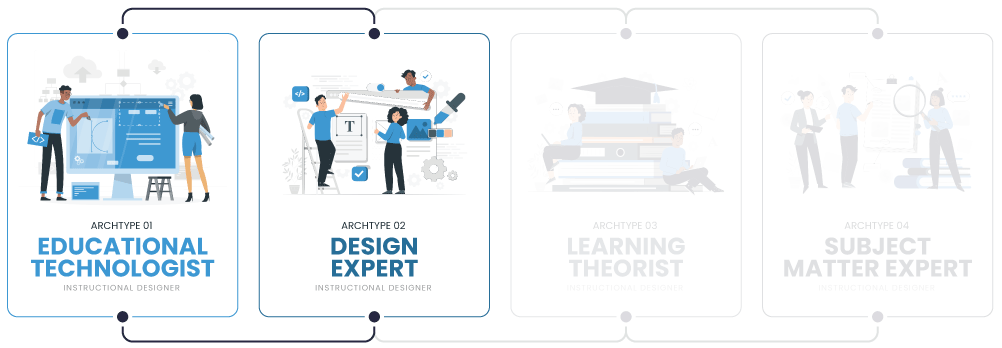
The Tech-Integrative Designer
At the intersection of the Educational Technology Archetype and Design Expertise Archetype, we find the professional who not only understands how to design visually appealing and effective learning experiences but also knows how to best integrate the latest technology tools and platforms to bring those designs to life.
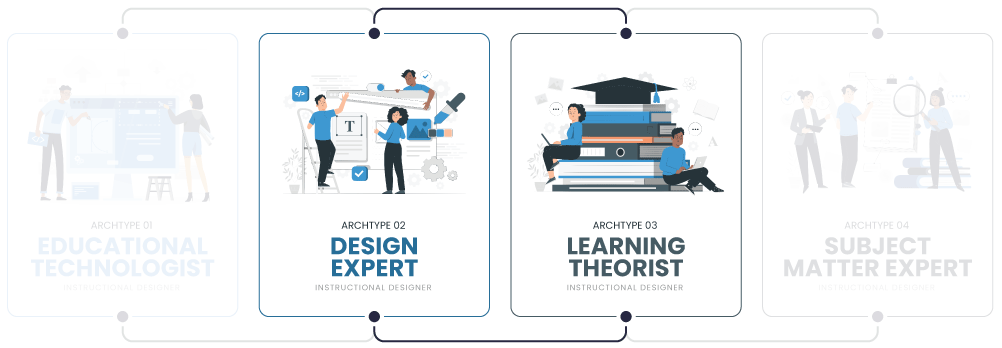
The Scholarly Designer
Combine the strengths of the Design Expertise Archetype and the Learning Theorist Archetype, and you get a designer who can create visually compelling content that is also rooted in solid educational theories.

The Scholarly SME
This overlap between the Learning Theorist Archetype and the SME ID Archetype is a powerhouse. These professionals are well-versed in their subject area and understand how to structure and present content based on established learning theories.
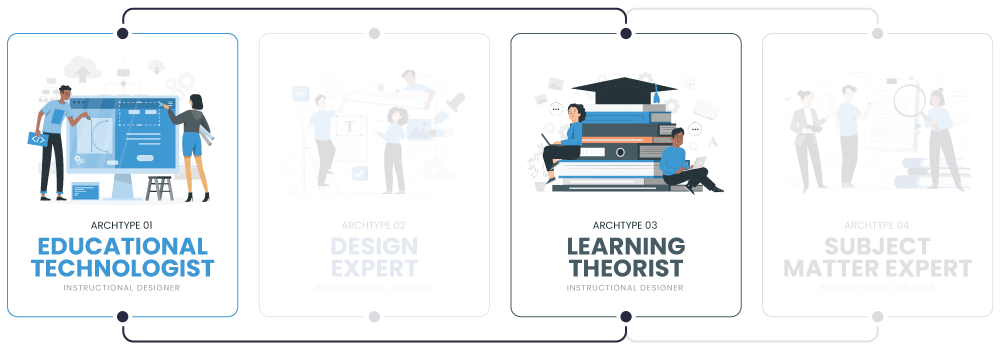
The Tech-Savvy Theorist
This is the blend of the Educational Technology Archetype and the Learning Theorist Archetype. These professionals are adept at harnessing technology to implement the best pedagogical practices, ensuring that learning is both effective and engaging.
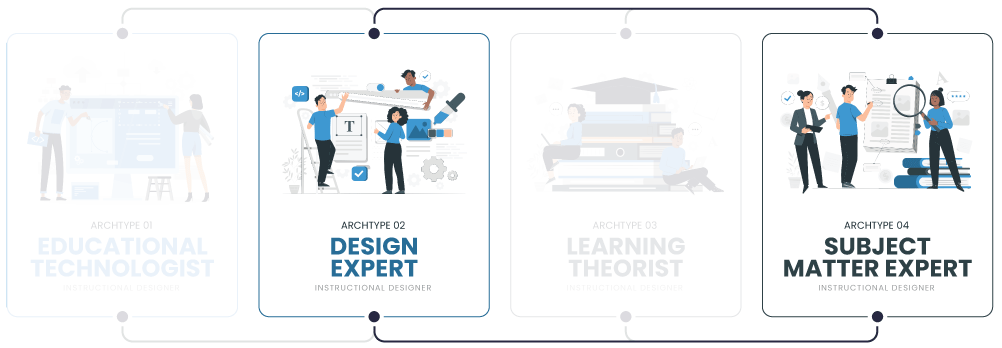
The Expert Designer
At the intersection of the Design Expertise Archetype and SME ID Archetype is the professional who not only possesses deep knowledge in a particular subject, but can also design content in a way that makes it compelling and accessible to learners.
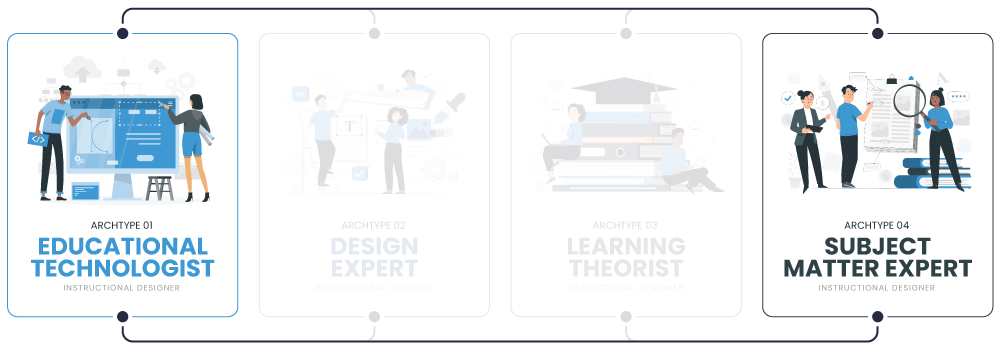
The Tech-Savvy SME
Here, the Educational Technology Archetype blends with the SME ID Archetype. These individuals can take complex subject matter and leverage technology to make it digestible and interactive for learners.
The Rarity and Value of Super-Archetypes
It’s worth noting that while these overlaps exist, an ID who truly excels in more than one archetype is rare and incredibly valuable. These professionals can navigate the complexities of their blended roles with finesse, making them highly sought after in the Instructional Design landscape.
In Closing
Embracing Diversity in Instructional Design
The Multifaceted Nature of ID
Instructional Design is a multifaceted field, enriched with the diverse skills, knowledge, and expertise that professionals bring to the table. The archetypes outlined here serve not to pigeonhole, but to celebrate the breadth of roles and the depth of skills inherent to our industry.
Recognizing Unique Value
It’s crucial for organizations to recognize the unique value each archetype brings, and for designers themselves to understand where their strengths lie and where they might grow.
Evolving with the Field
As the world of education and training continues to evolve, so too will the roles and responsibilities of Instructional Designers. By acknowledging and appreciating the vast array of talents within our community, we can collectively foster collaboration, inspire innovation, and drive excellence in every learning experience crafted.
A Toast to Every Designer
Whether you identify with a single archetype or find yourself straddling the lines between multiple, know that your contribution to the realm of Instructional Design is invaluable. Here’s to the continuous exploration, learning, and growth in our ever-expanding field. Cheers!




